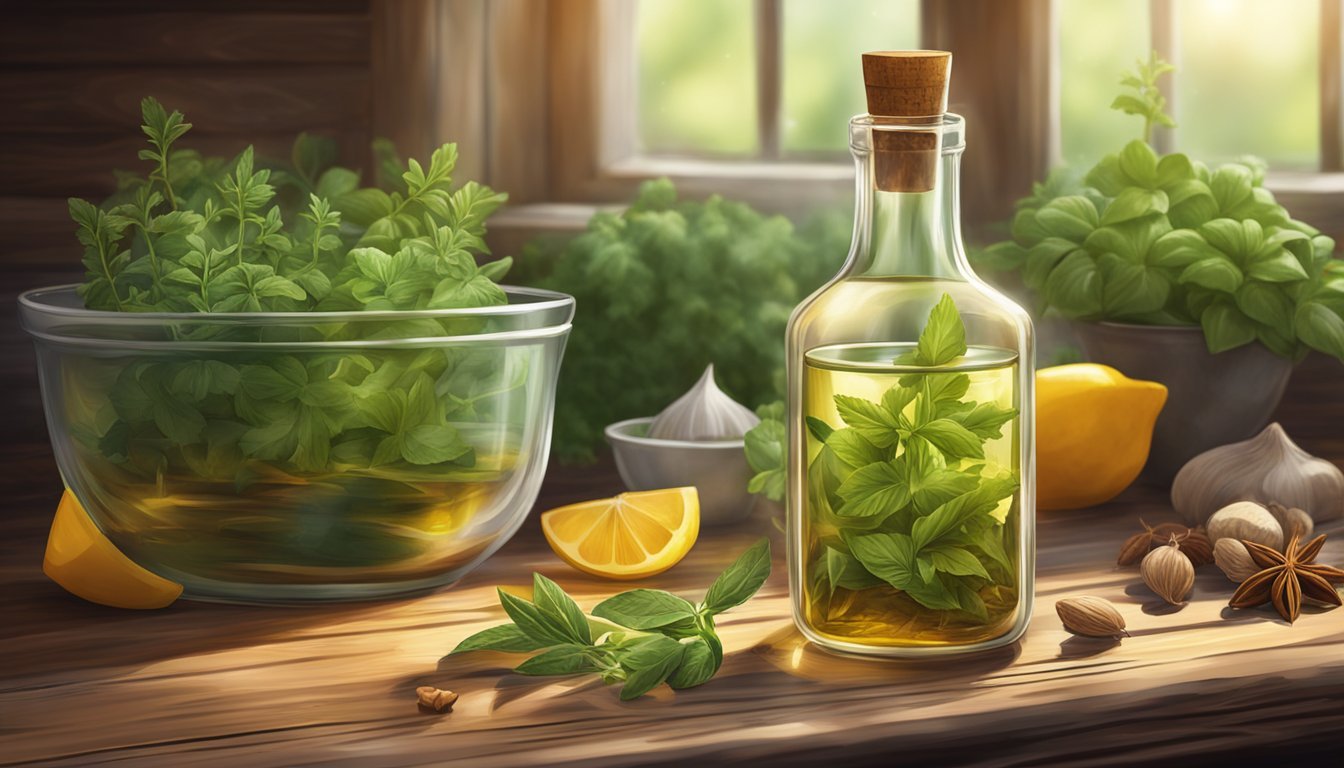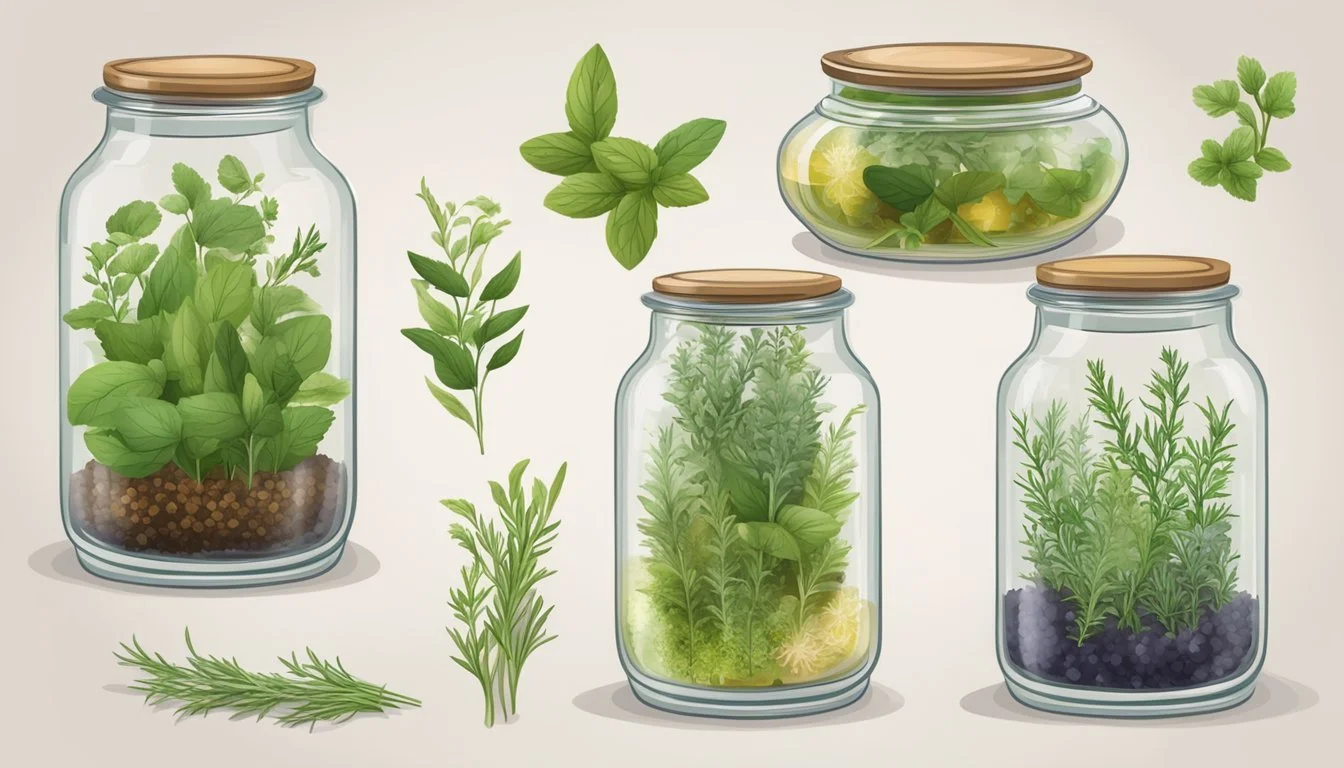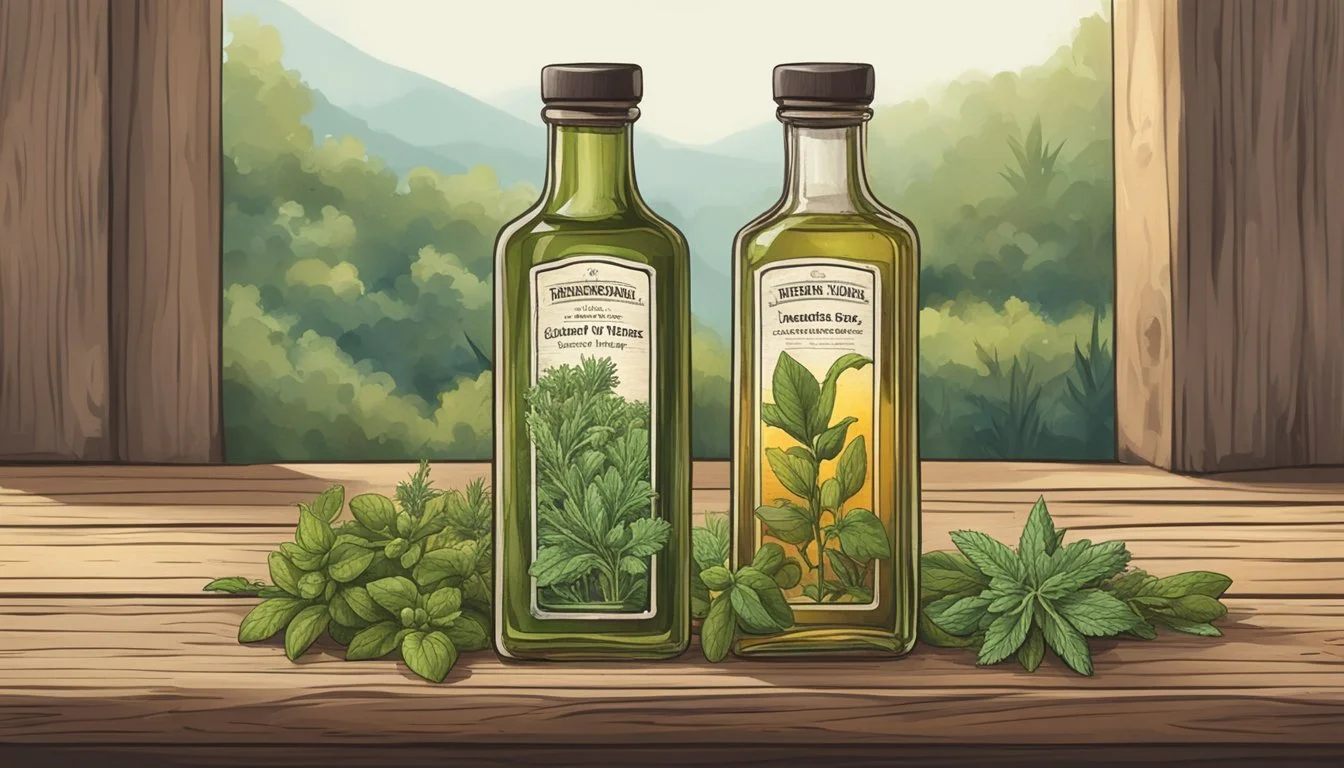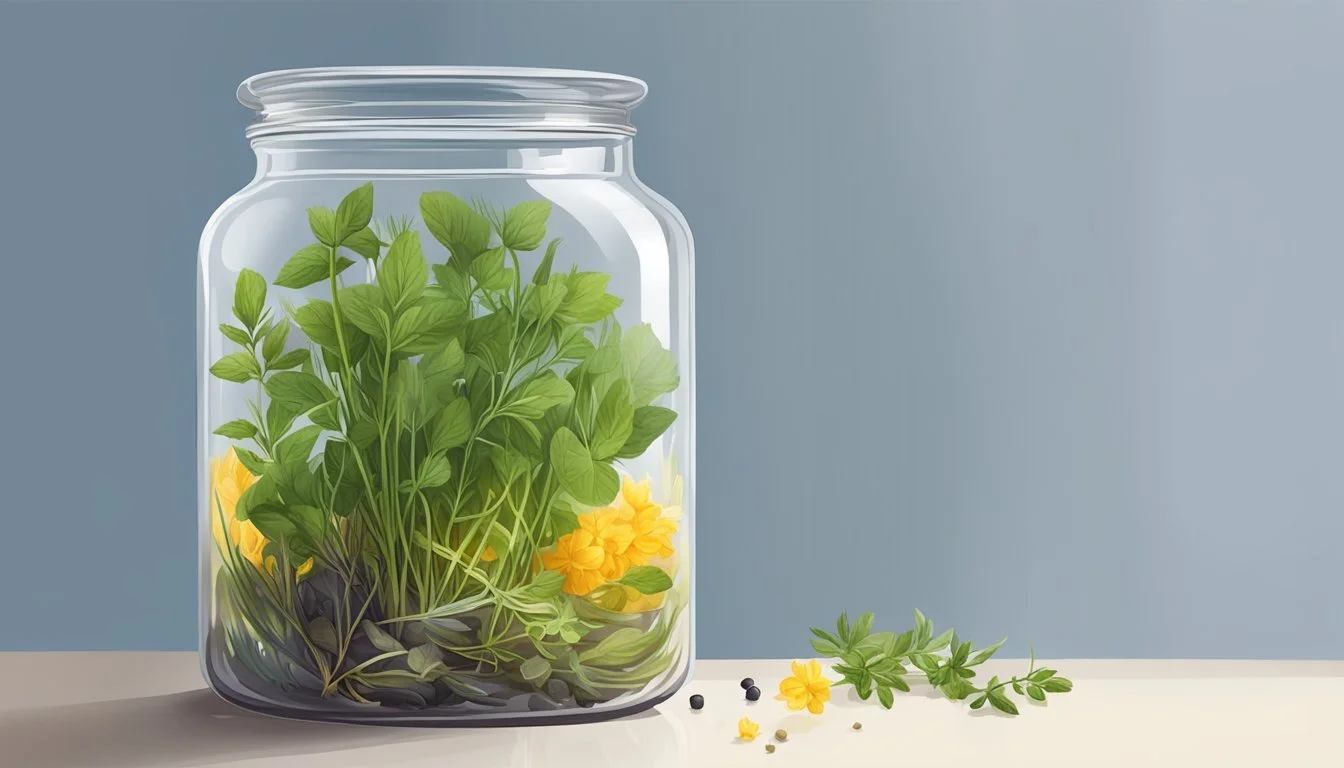Herb Stem Vinegar:
Elevating Flavors with a Homemade Infusion
Herb stem vinegar is a unique and aromatic infused condiment that has found its place in the pantries of culinary enthusiasts. Made by steeping the often-discarded stems of culinary herbs in vinegar, this infusion process extracts the essential oils and flavors, imparting a fragrant essence into the liquid. Not only does this reduce waste by utilizing the entire herb, but it also creates a versatile ingredient that can enliven salads, marinades, and dressings with its complex, herbaceous notes.
Culinary herbs, the cornerstone of this infused condiment, have been celebrated for their flavor and potential health benefits for centuries. By infusing the stems, which contain concentrated amounts of the herbs’ natural oils, into vinegar, these benefits are seamlessly carried into the vinegar itself. This process results in a condiment that not only enhances the taste of food but may also contribute positively to one's well-being.
Creating herb stem vinegar is a straightforward and rewarding process. The stems are broken to fit into a jar, covered with a vinegar of choice, and then allowed to sit until the desired potency is achieved. While each recipe may vary slightly, the basic principle remains consistent: the longer the stems are allowed to infuse, the stronger the flavor of the vinegar. Once strained, the delicate yet robust flavors of the herb stem vinegar are ready to be enjoyed as a fragrant addition to a variety of dishes.
Understanding Vinegar and Its Uses
Vinegar has been an essential ingredient in kitchens and pantries for its culinary versatility and preservative properties. This section will explore its historical roots, the various types available, and its applications in cooking and food preservation.
History and Production of Vinegar
Vinegar production dates back thousands of years, with evidence suggesting its use by ancient civilizations such as Babylonians and Egyptians. It is created through the fermentation of ethanol by acetic acid bacteria, which transforms alcohol into sour-tasting acetic acid.
Key Points:
Ancient Origins: Vinegar's usage is recorded in civilizations such as Egypt and Babylon.
Fermentation Process: Ethanol from alcoholic liquids ferments into acetic acid.
Types of Vinegar
There are several distinct types of vinegar, each with unique flavors and uses:
Apple Cider Vinegar: Made from fermented apple juice, it is known for its fruity zest.
White Vinegar: Derived from grain alcohol, offering a sharp and clean taste suitable for cleaning and pickling.
Wine Vinegar: Produced from red or white wine; red wine vinegar has a robust flavor, while white wine vinegar is more mellow.
Champagne Vinegar: Made from champagne, noted for its delicate and light taste.
Rice Vinegar: Sourced from fermented rice, it has a subtle sweetness, common in Asian cuisine.
Balsamic Vinegar: Originating from Italy, it is aged and concentrated, with a rich, sweet flavor.
Vinegar in Cooking and Food Preservation
Vinegar's acidity makes it ideal for various culinary applications:
Flavor Enhancer: Adding zest to dressings, marinades, and sauces.
Preservative: Extending shelf life of foods through pickling.
Tenderizing Agent: Breaking down proteins in meat marinades.
Its use in food preservation exploits its antimicrobial properties, inhibiting bacteria growth and thus extending the freshness and edibility of preserved items.
Essential Herbs for Infused Vinegars
Infused vinegars capture the essence of herbs, transforming the ordinary acetic solution into a fragrant condiment. The selection of herbs and their form—fresh or dried—determines the intensity and quality of the flavor.
Selecting Herbs for Infusion
For infusing vinegars, one should consider herbs that have robust and distinctive flavors. Culinary herbs such as tarragon, rosemary, basil, thyme, and oregano are popular for their strong profiles that infuse well. Garlic and fennel can add a savory depth, while lavender, sage, and mint give a unique twist with their aromatic properties.
Tarragon: Offers a subtle anise-like flavor, excellent for chicken dishes.
Rosemary: Its piney taste enhances red meats and stews.
Basil: Brings a sweet and peppery flavor, ideal with tomatoes.
Thyme: Notes of lemon and mint, pairs well with soups and vegetables.
Oregano: Has a bold and earthy aroma, complements Italian cuisine.
Other herbs like dill, chives, parsley, and sage can be experimented with to create bespoke blends that pair with specific dishes or cuisines.
Benefits of Fresh versus Dried Herbs
Fresh Herbs offer a vibrant and often more nuanced flavor profile compared to dried. They impart a brighter aesthetic to the vinegar and are typically used in larger quantities due to their milder flavor.
Pros: Brighter color, subtle flavors.
Cons: Shorter shelf life, requires more herbs for infusion.
On the other hand, Dried Herbs tend to have a more concentrated flavor, making them ideal for long-term storage and potent infusions.
Pros: Long shelf life, strong flavors, less volume required.
Cons: May need to filter out bits after infusion, aesthetics less vibrant.
It's essential to use clean, sterilized containers regardless of the herb form to prevent spoilage and ensure safety. Fresh herbs should be thoroughly washed and patted dry to eliminate moisture that could affect the infusion process. Dried herbs need no such preparation but should be of high quality to ensure a robust flavor profile in the final product.
The Art of Infusing Vinegar
Creating infused vinegar is a simple yet rewarding process, combining the sharpness of vinegar with the aromatic qualities of herbs. One embarks on a sensory journey that elevates the culinary experience while also offering a pleasing gift option for food enthusiasts.
Preparing Ingredients
The first step is selecting fresh herbs. One must carefully rinse and pat them dry to ensure cleanliness. For more potent flavors, they should use the stems and leaves of the herb or a combination of both. A clean glass jar is essential to prevent any contaminants from affecting the infusion. For heat infusions, they must gently warm the vinegar before adding herbs to expedite the infusion process.
Select fresh, quality herbs.
Clean and dry all herbs and equipment.
Pre-warm vinegar for heat infusion methods.
Infusion Techniques
There are two primary techniques for infusing vinegar: cold and heat infusion. In cold infusion, one places herbs directly into a mason jar and covers them with vinegar, allowing the mixture to sit for a period ranging from a couple of weeks to up to a month. They need to ensure the vinegar fully submerges the herbs to prevent mold growth. For a heat infusion, one should pour hot vinegar over the herbs and then seal the jar. Heat infusion typically requires a shorter period before achieving the desired flavor strength.
Cold infusion: herbs remain in room-temperature vinegar for an extended period.
Heat infusion: hot vinegar poured over herbs for a quicker process.
Storage and Shelf Life
Once infused to the desired level of flavor, it's crucial to strain the herbs using a cheesecloth or another fine-mesh filter. Transferring the strained liquid into a sterilized jar or bottle is the next step. For preservation, one should store the herbal vinegar in a cool, dark place or in the refrigerator. While some may remain shelf-stable at room temperature, refrigeration can help extend the shelf life. Properly stored, homemade herbal vinegars can last up to three months.
Strain through cheesecloth and store in sterilized jars or bottles.
Keep in a cool, dark place or refrigerate.
Use within three months for best flavor and quality.
Creative Uses for Herb Stem Vinegar
Herb stem vinegar, crafted from the often-discarded stems of herbs, offers a fragrant twist to culinary creations and self-care routines. It unites the robust essence of herbs with the tangy base of vinegar to enhance a variety of applications.
In Salad Dressings and Marinades
Herb stem vinegar shines in salad dressings, where its acidity balances the oils and adds a layer of depth to simple green salads. A basic vinaigrette can be transformed with its inclusion:
Combine 3 parts oil to 1 part herb stem vinegar
Add a teaspoon of mustard for emulsification
Season with salt and pepper to taste
For marinades, the vinegar acts as a tenderizing agent for proteins while infusing them with herbal notes. It pairs especially well with poultry and vegetables, lending a subtle, earthy flavor.
As a Flavor Enhancer for Cooked Dishes
This vinegar can elevate cooked dishes such as soups or stews with a splash added just before serving. It imparts a bright note and helps to layer flavors in vegan dishes where complexity is sometimes needed.
Stir into potato salad for a zesty kick
Drizzle over roasted vegetables to accentuate their natural sweetness
Add to fruit compotes or reductions to contrast the sweetness of berries, apples, or pineapple
Herb Vinegar in Health and Beauty
Beyond the kitchen, herb stem vinegar offers healthy, natural benefits in the realm of beauty. As a hair rinse, it can clarify the hair shaft, leaving strands looking lustrous. Try diluting one part herb vinegar with two parts water for a refreshing scalp treatment.
In the bath, a cup of herb stem vinegar can soften the skin and provide a soothing aroma, transforming a simple soak into a therapeutic experience. This is an approachable and sustainable way for individuals to integrate natural products into their self-care regime.
Decorative and Practical Packaging of Herb Vinegar
Packaging herb vinegar beautifully enhances its appeal while ensuring its longevity. Quality containers, proper labeling, and a personal touch can transform a simple jar of infused vinegar into an attractive and thoughtful gift.
Selecting the Right Containers
When choosing containers for herb vinegar, one should opt for glass jars due to their non-reactive nature and aesthetic clarity. Mason jars and canning jars are popular choices; they come in various sizes and are often equipped with tight-sealing lids, such as cork stoppers or screw tops, to preserve the vinegar's aroma and flavor. It's important to ensure the jars are clean and sterilized to prevent contamination.
Labeling and Decor
Effective labeling not only informs but also adds to the decorative aspect of the vinegar. Labels should include the type of herbs used, the date of infusion, and storage instructions. One can use high-quality paper and elegant fonts to create an appealing look. For an extra decorative touch, incorporate a few sprigs of dried herbs inside the jar or attach them to the outside with twine or ribbon.
Tips for Giving Herb Vinegar as Gifts
Herb vinegars make excellent gifts, especially when the packaging is considered as part of the present. Here are a few tips for gifting:
Select a jar that matches the style of the recipient; whether they prefer rustic or modern, the choice of jar can be tailored to their tastes.
Pair the herb vinegar with a set of recipe cards for dishes and dressings that include the vinegar as an ingredient.
If shipping the vinegar, pack it carefully to avoid breakage and ensure that the seal is secure to prevent leaks.
By focusing on the details of packaging, including the selection of jars, personalized labeling, and decorative elements, one can elevate the simple act of gifting homemade herb vinegar to a memorable and cherished gesture.
Advanced Techniques and Flavor Combinations
To create sophisticated and unique infusions, one must explore the full spectrum of flavor pairings and advanced infusion techniques. These methods enhance the aromatic quality of herb stem vinegar, giving culinary enthusiasts a chance to elevate their dishes.
Experimenting with Unusual Herbs and Spices
The world of herbs and spices offers a vast array of flavors beyond the common staples. Adventurous artisans might infuse vinegar with saffron for an exotic touch or star anise for a licorice-like aroma. Mustard seeds, when used correctly, can impart a subtle tangy heat. For a more complex profile, chive blossoms add a delicate onion-like flavor that is perfect for a savory twist.
Incorporating Fruits and Citrus Peels
Infused vinegars can take on a refreshing zestiness with the addition of citrus. Whether one chooses lemon, lime, or orange, the citrus peel's essential oils contribute a bright note to the infusion. Adding citrus peels to herb vinegar not only heightens the fragrance but also introduces a layer of flavor complexity. Combining citrus with rose petals or floral notes like lavender can craft a beautifully fragrant concoction.
Developing Signature Blends
The true artistry in vinegar infusion lies in the creation of unique blends. A chef might pair the heat of peppers with the coolness of lemon balm for a contrasting flavor profile. A hint of cinnamon could complement the fiery notes of ginger, while lemongrass and bay leaves paired together might create an aromatic sensation evocative of Southeast Asian cuisine. One's signature blend becomes a personal trademark that can enhance any culinary creation.
Maintaining Quality and Safety in Herb Vinegars
In crafting herb vinegars, ensuring the condiment's safety and preserving its high quality are paramount. Contaminants, mold, and improper storage can compromise both the flavor and safety of the vinegar.
Avoiding Contamination
To prevent contamination, one should always begin with clean, sterilized jars or bottles. They should use fresh or thoroughly dried herbs free from decay. It is recommended to use a vinegar with at least a 5% acidity level as it inhibits bacterial growth. Hands and utensils must be washed before handling ingredients and vinegar.
Identifying and Dealing with Mold and Rust
The presence of mold can be identified as a fuzzy growth on the surface of the vinegar or on the herbs within it. If mold appears, they must discard the entire batch to prevent the risk of consuming harmful mycotoxins. Rust on jar lids can contaminate the vinegar. Using jars with plastic lids or vinegar-proof lids can mitigate this risk. If rust is found, the affected vinegar should be discarded.
Best Practices for Long-Term Storage
For long-term storage, they should keep herb vinegars in a cool, dark place such as a pantry or a cabinet. To enhance shelf life, storing the vinegar in the refrigerator is ideal, particularly after opening. Vinegar must be stored in an airtight container to maintain its quality over time. If any off flavors or odors are detected upon opening, it is best to compost the vinegar rather than risk consumption.
Engaging with the Community and Sharing Your Creations
When a DIY enthusiast creates a fragrant batch of herb stem vinegar, sharing the results and engaging with the wider community can bring both inspiration and valuable feedback. Social media platforms offer vast opportunities for presentation, while connecting with fellow DIY aficionados fosters collaboration and learning.
Social Media Presentations
Instagram and other social media platforms serve as excellent stages for showcasing homemade herb stem vinegar. Enthusiasts should consider the following steps to create an enticing post:
Capture High-Quality Images: Bright, clear photos that highlight the unique color and texture of the vinegar.
Craft Engaging Captions: Include a brief story about the creation process or the inspiration behind the recipe.
Use Relevant Hashtags: Increase visibility by incorporating tags like
#HerbVinegar,#InfusedVinegar, and#DIYcondiments.
Consistency in posting can help build a dedicated following, while engaging with comments maintains a strong bond with the audience.
Connecting with Other DIY Enthusiasts
Establishing connections with others in the DIY community can lead to the exchange of techniques and ideas. Some strategies include:
Participating in DIY Forums and Groups: Share experiences and seek advice on platforms dedicated to home crafting and cooking.
Attending Local Workshops or Events: These gatherings are opportune moments to showcase vinegar creations and engage in live demonstrations.
By actively participating in these spaces, individuals not only share their own creations but also contribute to the collective knowledge and appreciation of the art of infusion.
Seasonal and Occasional Inspirations for Herb Vinegars
Herb vinegars offer a unique way to capture the essence of the seasons, providing vibrant flavors in spring and summer, and warming, comforting tones during winter. They are a staple for infusing seasonal and occasional nuances into culinary creations.
Spring and Summer Flavors
As the days grow longer and the earth thaws, a bounty of fragrant, tender herbs beckons. Infused vinegars of this season should reflect the bright, green, and floral notes characteristic of the time.
Spring: Incorporate herbs like chives, dill, and parsley for a fresh, green taste.
Example: Chive Blossom Vinegar—a delicate pink hue and a gentle onion flavor, perfect for salad dressings.
Summer: Rely on robust, sun-loving herbs such as basil, thyme, and rosemary.
Example: Basil Infused Vinegar—ideal for Italian dishes or drizzling over ripe tomatoes.
Warm and Cozy Winter Blends
Winter's chill calls for hearty flavors that warm the soul. Think of herbs that pair well with richer meals and can stand up to stronger, fuller-bodied vinegars.
Winter: Sage, bay leaves, and oregano are excellent choices for their ability to infuse depth and warmth.
Example: Sage and Rosemary Vinegar—a woody, earthy blend, great for hearty stews and marinades.








